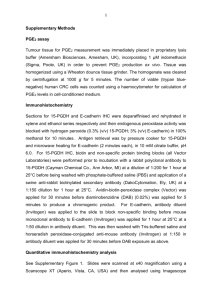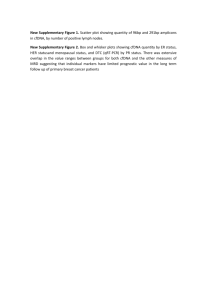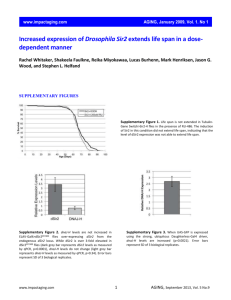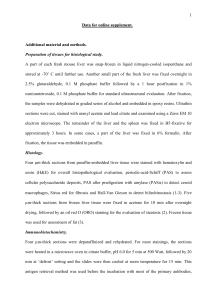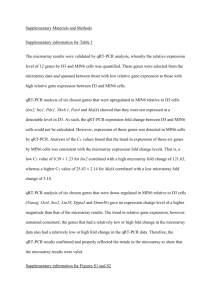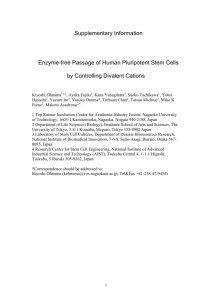hepr12599-sup-0001-SI
advertisement
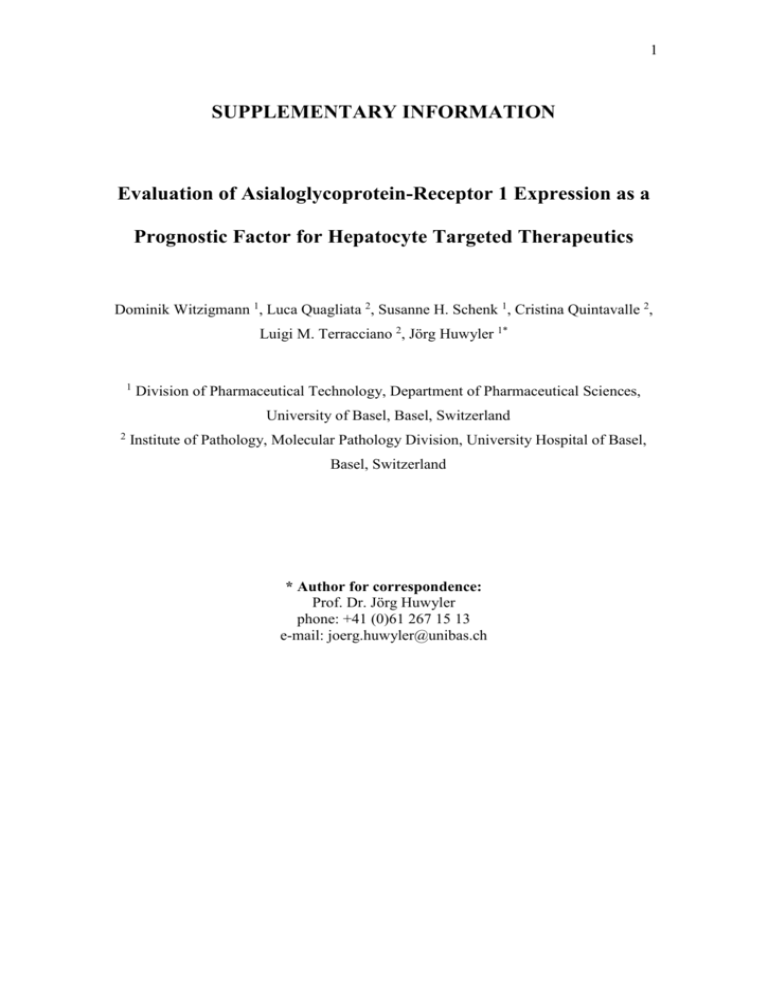
1 SUPPLEMENTARY INFORMATION Evaluation of Asialoglycoprotein-Receptor 1 Expression as a Prognostic Factor for Hepatocyte Targeted Therapeutics Dominik Witzigmann 1, Luca Quagliata 2, Susanne H. Schenk 1, Cristina Quintavalle 2, Luigi M. Terracciano 2, Jörg Huwyler 1* 1 Division of Pharmaceutical Technology, Department of Pharmaceutical Sciences, University of Basel, Basel, Switzerland 2 Institute of Pathology, Molecular Pathology Division, University Hospital of Basel, Basel, Switzerland * Author for correspondence: Prof. Dr. Jörg Huwyler phone: +41 (0)61 267 15 13 e-mail: joerg.huwyler@unibas.ch 2 Supplementary Methods Cell Lines Liver cancer-derived lines HepG2, PLC/PRF/5, Hep3B, Sk-Hep1, and SNU449 were obtained from the cell depository of the Institute of Pathology, University Hospital of Basel, Switzerland. HuH6 and HuH7 were obtained from RIKEN Cell Bank (Ibaraki, Japan). HLE was obtained from the Health Science Research Resources Bank (Osaka, Japan). Mahlavu was kindly provided by Sanofi Aventis. Prof. Dr. Dietrich von Schweinitz (University Hospital Basel, Switzerland) kindly provided the HepT1 cell line 1. The stable mouse NIH/3T3 fibroblast cell line 1-7-1, which expresses both ASGPR subunits, was provided by Prof. Dr. Martin Spiess 2. LiverPool 20-Donor Mixed Gender Pooled Cryopreserved Human Hepatocytes were obtained from BioreclamationIVT. All cell lines were cultured as recommended by the provider. Relative mRNA expression analysis of ASGR1 in vitro using qRT-PCR Total RNA for the quantitative real-time polymerase chain reaction (qRT-PCR) was isolated from cell lines at 80% confluence using TRI Reagent (Sigma Aldrich) according to the manufacturer´s recommendation. Total RNA from Cryopreserved Human Hepatocytes was extracted directly after thawing using TRI reagent. After a DNAse digest, cDNA was synthesized using the ProtoScript M-MuLV Kit (New England BioLabs) with random hexamer primers. qRT-PCR for the quantification of ASGR1 mRNA expression was performed using predeveloped TaqManAssays (Invitrogen, Life Technologies) as described elsewhere 3. The measurements of ASGR1 mRNA (Hs01005019_m1) were normalized to four different housekeeping genes, namely beta-actin (Hs99999903_m1), GAPDH (4310884E), PPIA (Hs99999904_m1), 3 and RPLP0 (Hs99999902_m1). Relative mRNA expression in different cell lines was calculated using the standard ΔΔCt method 4. Flow Cytometry and Immunofluorescence Quantitative analysis of ASGR1 protein expression in the different cell lines was performed using flow cytometry analysis. The cells were incubated with the primary anti-ASGR1 antibody (HPA011954; Prestige Antibodies®, dilution 1:25) at RT for 45 min, followed by incubation at 4°C with secondary R-PE GαR antibody (Invitrogen, Life Technologies, dilution 1:200) for 60 min. Cells were excited at 561 nm and doublets were excluded. The fluorescence signal of R-PE was detected in FL5 (586/15). To analyze the relative ASGR1 protein expression FlowJo VX software (TreeStar) was used. Immunofluorescence analysis for qualitative assessment of ASGR1 protein expression was performed using confocal laser scanning microscopy (CLSM). Cell lines were seeded on poly-D-lysin coated coverslips and allowed to adhere for 24 hours. Cells were fixed with 4% paraformaldehyde for 15 min and incubated with the primary anti-ASGR1 antibody (HPA011954; Prestige Antibodies®, dilution 1:25) one hour at RT. After three washing steps the secondary Alexa Fluor® 488 GαR antibody (Invitrogen, Life Technologies, dilution 1:400) was added and cells were incubated overnight at 4°C. After additional washing steps the nuclei were counterstained using Hoechst 33342 (1 µg/mL). Finally, the cover slips were embedded in Prolong Gold antifade reagent (Invitrogen, Life Technologies). The cells were excited at 488 nm and the fluorescence was measured above 516 nm. Background fluorescence was assessed using unstained cells. 4 Relative mRNA expression of ASGR1 in human liver tissue samples RNA for the microarray was isolated and handled as previously described 5. Briefly, extracted RNA quality and quantity were analysed with the Bioanalyzer 2100 using the RNA6000 Chip (Agilent). DNAse-treated total RNA (270 ng) was subjected to target synthesis using the WT Expression kit (Ambion) following standard recommendations. Then the array was hybridised. The GeneChips were scanned with an Affymetrix GeneChip Scanner 3000. DAT images and CEL files of the microarrays were generated using Affymetrix GeneChip Command Control (v4.0). CEL files were imported into Qlucore software and Robust Multichip Average (RMA), normalized, and principal component analysed. Quantile normalization and data processing were performed using the GeneSpringGXv11.5.1 software package (Agilent). The gene signature value was assessed using the BRB-ArrayTool (v4.3.2, NIH). Ingenuity software (Qiagen) was used to perform pathway analysis. Tissue Microarray (TMA) and Immunohistochemistry TMA sections (4 µm thick) were immuno-stained with an anti-ASGR1 primary antibody (Prestige Antibodies®, dilution 1:50) or an anti-CD3 primary antibody (Dako, dilution 1:1600), followed by a HRP-conjugated secondary antibody using a ventana system (Roche Diagnostics). Finally, the slides were stained with hematoxylin and eosin. ASGR1 protein immunoreactivity was scored semi-quantitatively by evaluating the staining intensity as described by Allred et al. 6 (0=negative for ASGR1 and 3=highest intensity of ASGR1). Clinico-pathological data of the different HCC subsets are summarized in Supplementary Table 1. CD3 protein staining was scored as % of infiltrating inflammatory cells. 5 Supplementary Figures Figure S1. Qualitative evaluation of ASGR1 protein expression in different cell lines by confocal laser scanning microscopy analysis. Representative immunofluorescence images of ASGR1 protein (green) expression in different liver cancer-derived cell lines such as (a) HepG2, (b) PLC/PRF/5, (c) Hep3B, (d) HuH6, (f) HuH7, (g) SNU449, (h) Sk-Hep1, (i) Mahlavu, (k) HLE, and (l) HepT1. Panel (m) shows primary human hepatocytes (PHH), and panel (e) the human ASGPR-expressing mouse fibroblast cell line 1-7-1. Scale bars represent 20 µm. 6 Supplementary Tables Supplementary Table 1: Summary of ASGR1 protein levels in correlation with clinico-pathological factors. Semi-quantitative evaluation of staining intensity in hepatocellular carcinoma (n = 184) tissue specimens by tissue microarray (TMA) analysis. Results were analyzed using the Chi-square test (χ2 test). Corresponding p values are given. Factors ASGR1 Staining Score n (%) 0 1 2 Age </=65 27 (57.4) 8 (17.0) 9 (19.1) >65 80 (58.4) 34 (24.8) 19 (13.9) Gender Female 22 (56.4) 9 (23.1) 6 (15.4) Male 85 (58.6) 33 (22.8) 22 (15.2) Nstage 0 87 (54.0) 40 (24.8) 27 (16.8) (11 missing values) 1 10 (83.3) 2 (16.7) 0 (0.0) Tstage 1-2 61 (52.6) 29 (25.0) 21 (18.1) (18 missing values) 3-4 32 (64.0) 11 (22.0) 5 (10.0) Mstage 0 80 (53.3) 37 (24.7) 26 (17.3) (11 missing values) 1 17 (73.9) 5 (21.7) 1 (4.3) Edmondson stage Well (I) 38 (52.1) 18 (24.7) 16 (21.9) (4 missing values) Moderate (II) 47 (57.3) 21 (25.6) 9 (11.0) Poor (III) 19 (76.0) 3 (12.0) 2 (8.0) Multifocality No 38 (49.4) 22 (28.6) 14 (18.2) (9 missing values) Yes 62 (63.3) 19 (19.4) 13 (13.3) Vascular Invasion No 53 (54.6) 27 (27.8) 13 (13.4) (25 missing values) Yes 38 (61.3) 9 (14.5) 12 (19.4) Etiology Alcohol 20 (62.5) 9 (28.1) 2 (6.3) (62 missing values) Viral 48 (53.3) 21 (23.3) 18 (20.0) Infection 3 3 (6.4) 4 (2.9) 2 (5.1) 5 (3.4) 7 (4.3) 0 (0.0) 5 (4.3) 2 (4.0) 7 (4.7) 0 (0.0) 1 (1.4) 5 (6.1) 1 (4.0) 3 (3.9) 4 (4.1) 4 (4.1) 3 (4.8) 1 (3.1) 3 (3.3) χ2 2.682 p 0.4433 0.02821 0.9988 4.551 0.2078 2.416 0.4907 4.805 0.1867 9.718 0.1370 3.693 0.2966 4.152 0.2455 3.302 0.3474 7 Supplementary Table 2: Summary of ASGR1 protein expression on cell membrane in tissue samples from normal liver, hepatocellular carcinoma (HCC), and cirrhotic nodules. Qualitative evaluation of ASGR1 membrane expression in ASGR1 protein positive samples from normal liver (n = 45), HCC (n = 77), and cirrhotic nodules (n = 65) was performed using tissue microarray (TMA). Results were analyzed using the Chi-square test (χ2 test). Corresponding p values are given. Tissue Type Normal liver HCC ASGR1 Membrane Score n (%) 0 1 14 (31.1) 31 (68.9) 50 (64.9) 27 (35.1) Normal liver Cirrhotic nodules 14 (31.1) 53 (81.5) Cirrhotic nodules HCC 53 (81.5) 50 (64.9) χ2 13.030 p 0.0003 31 (68.9) 12 (18.5) 28.400 < 0.0001 12 (18.5) 27 (35.1) 4.887 0.0272 8 Supplementary References 1. Pietsch T, Fonatsch C, Albrecht S, et al. Characterization of the continuous cell line HepT1 derived from a human hepatoblastoma. Lab Invest 1996;74:809-818. 2. Bider MD, Cescato R, Jenö P, et al. High-affinity ligand binding to subunit H1 of the asialoglycoprotein receptor in the absence of subunit H2. Eur J Biochem 1995;230:207212. 3. Meyer Zu Schwabedissen HE, Begunk R, Hussner J, et al. Cell-specific expression of uptake transporters--a potential approach for cardiovascular drug delivery devices. Mol Pharm 2014;11:665-672. 4. Schmittgen TD, Livak KJ. Analyzing real-time PCR data by the comparative C(T) method. Nat Protoc 2008;3:1101-1108. 5. Quagliata L, Matter MS, Piscuoglio S, et al. Long noncoding RNA HOTTIP/HOXA13 expression is associated with disease progression and predicts outcome in hepatocellular carcinoma patients. Hepatology 2014;59:911-923. 6. Allred DC, Harvey JM, Berardo M, et al. Prognostic and predictive factors in breast cancer by immunohistochemical analysis. Mod Pathol 1998;11:155-168.



